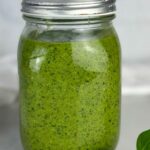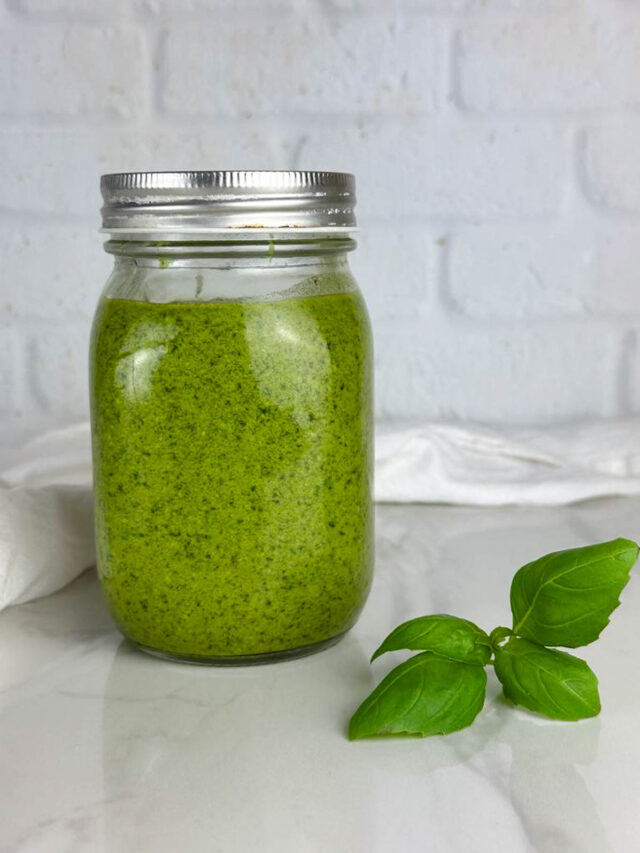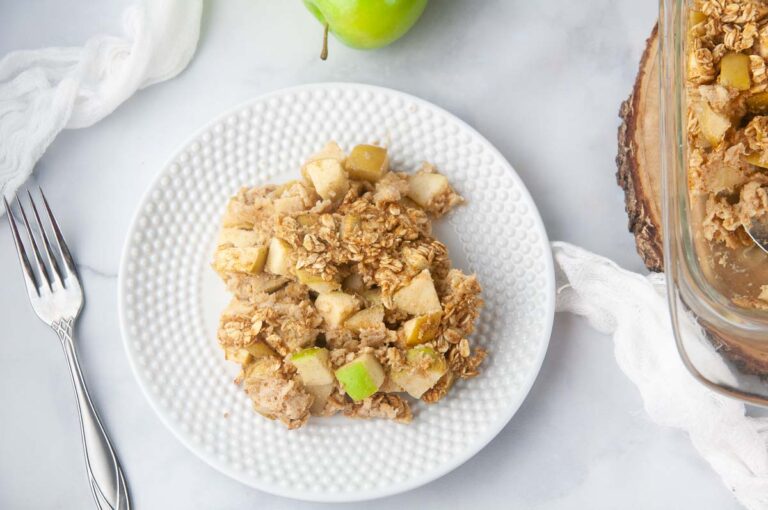Basil Pesto Sauce with Walnuts (Pesto Sauce without Pine Nuts)
Our basil pesto sauce with walnuts skips the pine nuts altogether for an easy alternative of this classic sauce. Homemade basil walnut pesto makes a delicious addition to pasta, gnocchi, salads, and meats. Make it and never go back to store bought!
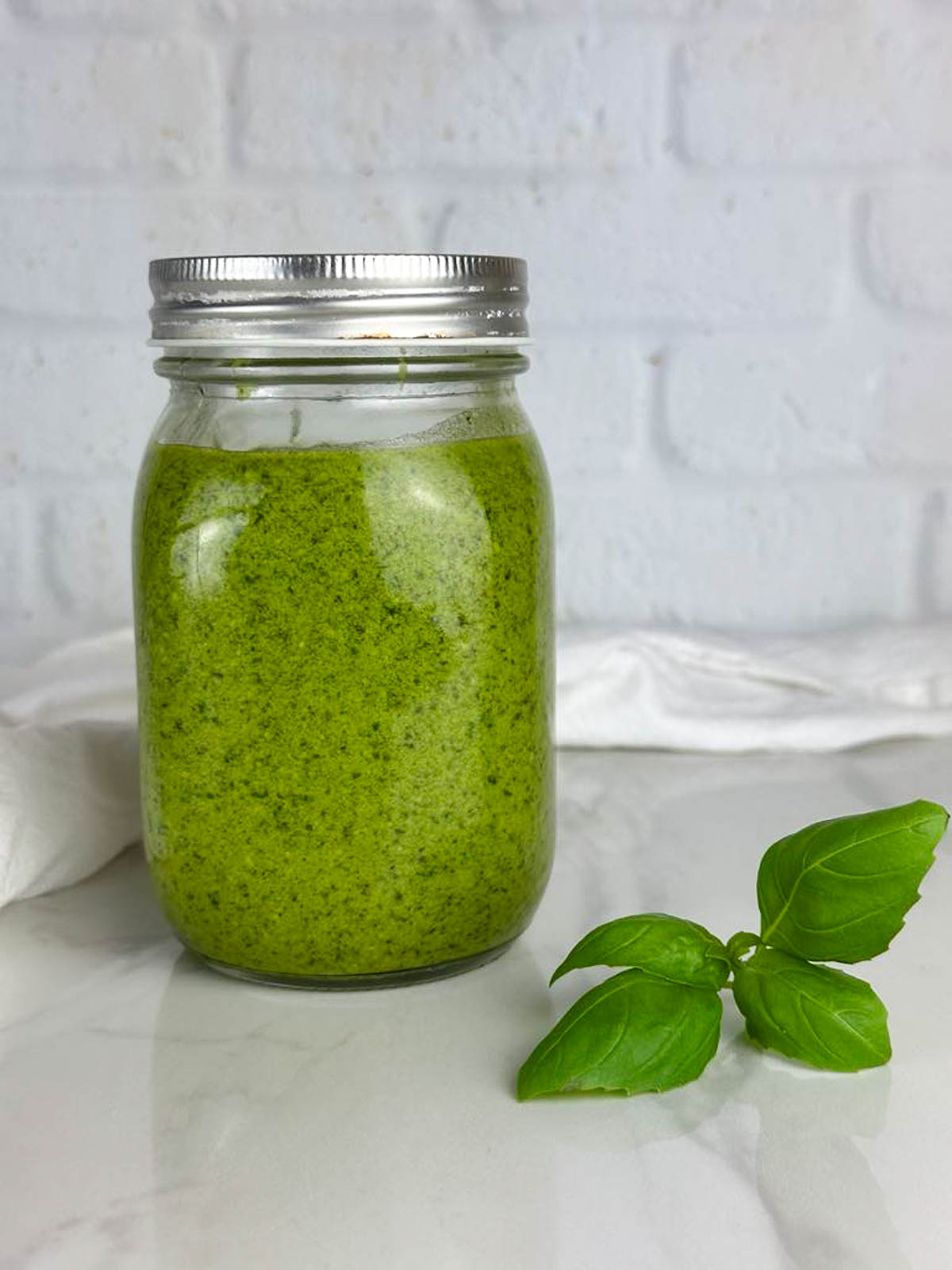
Post may contain affiliate links. As a member of the Amazon affiliate program, I may earn a small commision from qualifying purchases. To read my affiliate policy, click here.
Every year, we plant planters full of fresh basil in the spring.
By summer, I have so much basil that I almost don’t know what to do with.
*Almost.*
Because the answer is obviously make homemade basil pesto sauce.
(My answer to almost everything is make sauce btw be it pesto or homemade spaghetti sauce.)
It’s so easy to make it and since we making basil pesto with walnuts instead of pine nuts, it’s not so expensive.
And the flavor.
Bright, fragrant basil, a bit of bite from the garlic, salty savoriness from the cheese, fruity richness from the olive oil, and of course a nutty background from the walnuts.
It’s so good I eat it right off the spoon and put it on everything from pasta and gnocchi to sandwiches and salads and even spoon it over grilled chicken.
Why Make Basil Pesto with Walnuts
Yes, traditional pesto Genovese is made with pine nuts.
That’s great.
Pine nuts are super yummy.
But they are also somewhat hard to find with some grocers not even carrying them.
And they are expensive.
Real expensive.
You can buy 6 ounces of walnuts for over a dollar less than the cost of 2.25 ounces of pine nuts.
(Of course, this may vary based on what store you are heading to.)
Ingredients and Kitchen Supplies
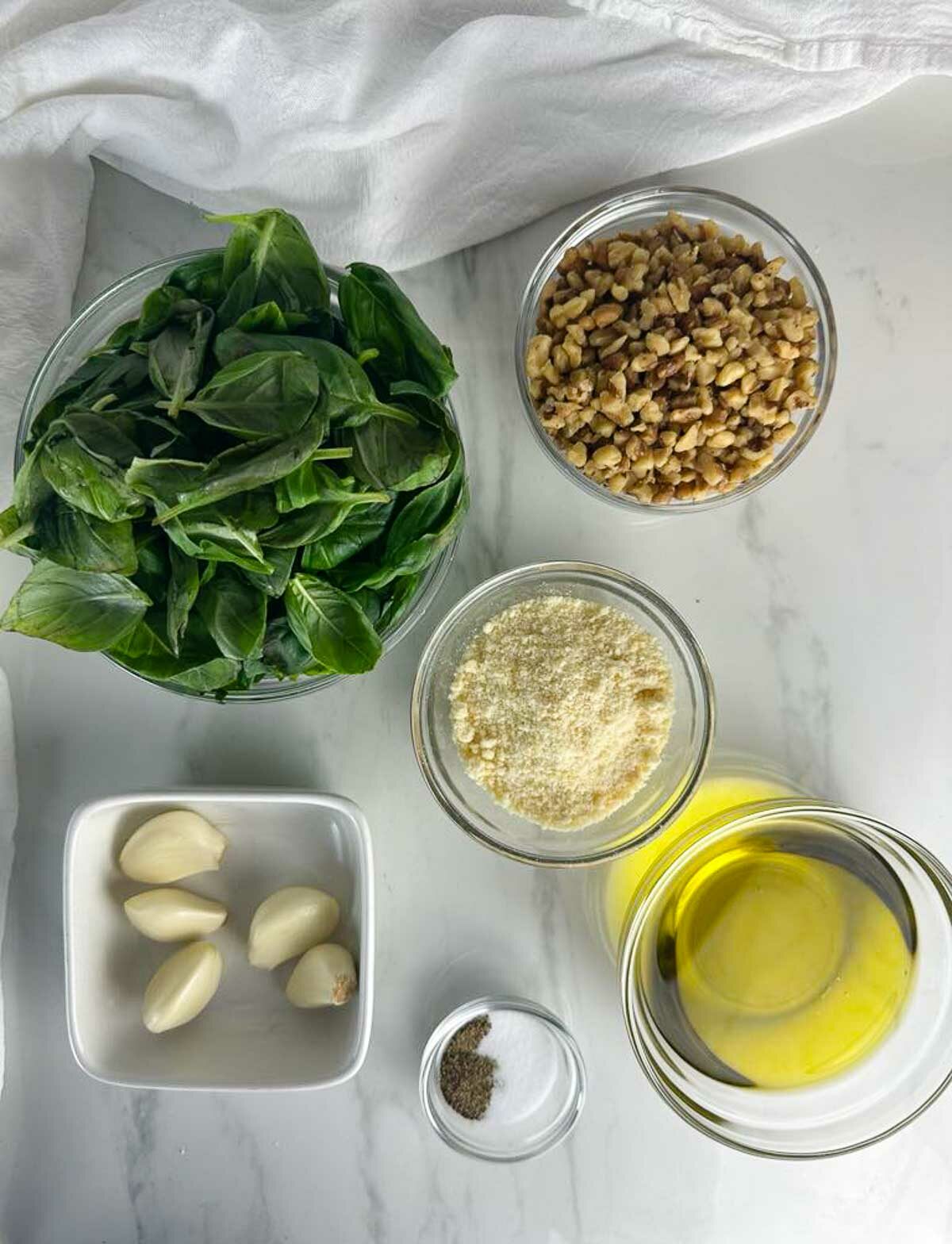
To make basil pesto sauce without pine nuts, you’ll need:
- Walnuts – You can use whole, half, or chopped. We find that using chopped works well when mixing the basil pesto sauce.
- Fresh basil – You’ll need about a cup or a large bunch of basil.
- Fresh garlic – Garlic gives pesto sauce its bite and adds some good flavor.
- Olive oil – You can use your preferred brand. In a pinch, a light oil can work.
- Parmesan or romano cheese – You can use either parmesan or romano cheese or both if you like – why limit yourself?
- Salt and pepper – We use two healthy pinches of it, but you can add as much or little as you like.
We use the following equipment when we make pestoa sauce with walnuts:
- Food processor – A good food processor chops up all the ingredients and creates the pesto sauce quickly.
- High power blender – If you don’t have a food processor, you can use a high power blender to mix it altogether.
How to make Pesto Sauce with Walnuts
1. Mix the basil pesto sauce
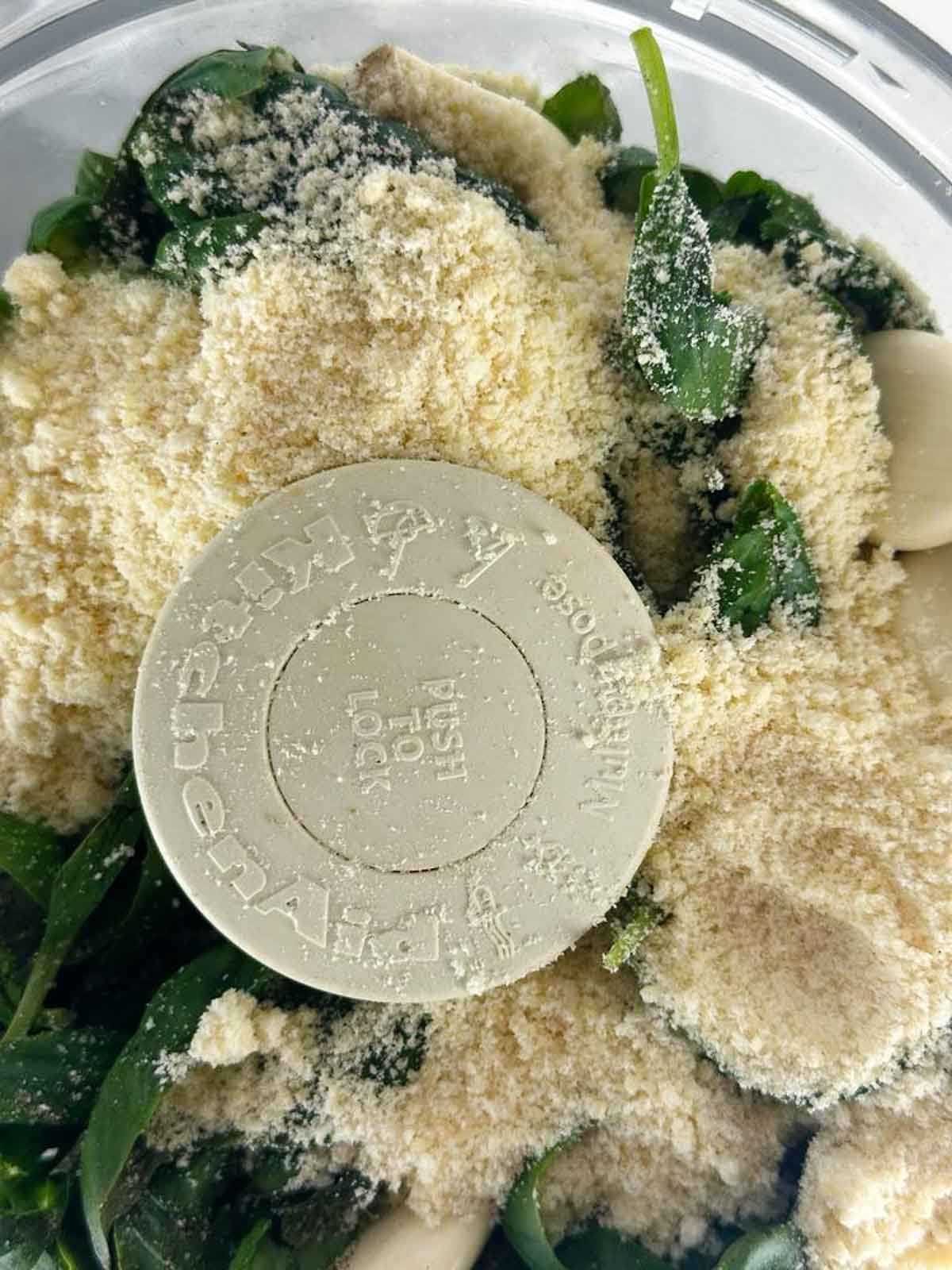
Add all the ingredients except the olive oil to the bowl of food processor or high power blender.
Blend for about 30 seconds to 1 minute or until the sauce is sort of a paste like consistency.
If you use whole walnuts, you may need to mix for a bit longer or rough chop them before adding them to the food processor.
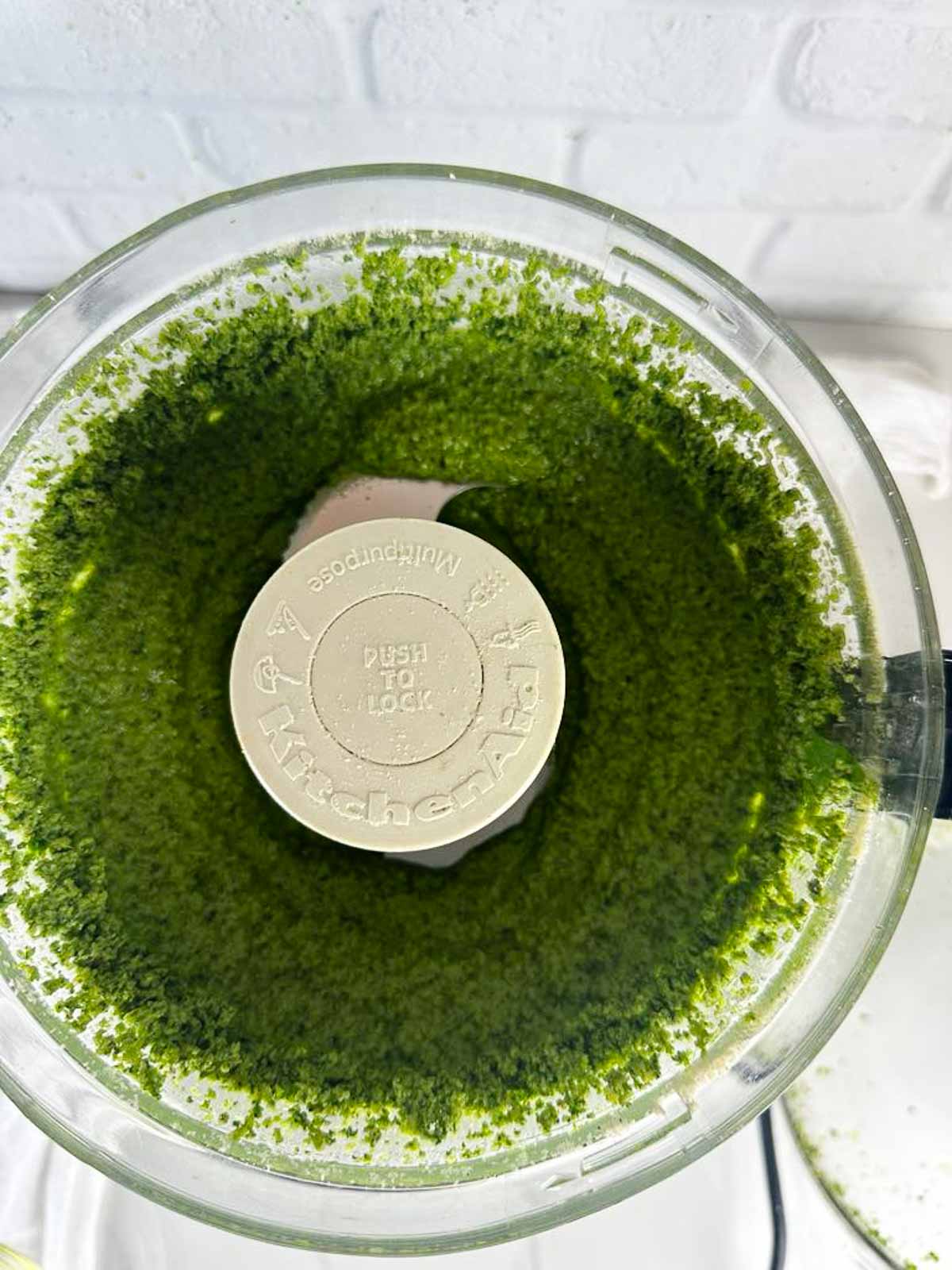
2. Stream the olive oil into the basil walnut pesto.
After you food process the basil, walnuts, cheese, and garlic to form the thick paste mixture, remove the cap from the feeder tube on the top of your food processor lid.
While pulsing the food processor, stream in 3/4 of a cup to 1 cup of olive oil.
At this point, stop pulsing the pesto sauce and take the lid off the food processor.
Check the consistency of your pesto.
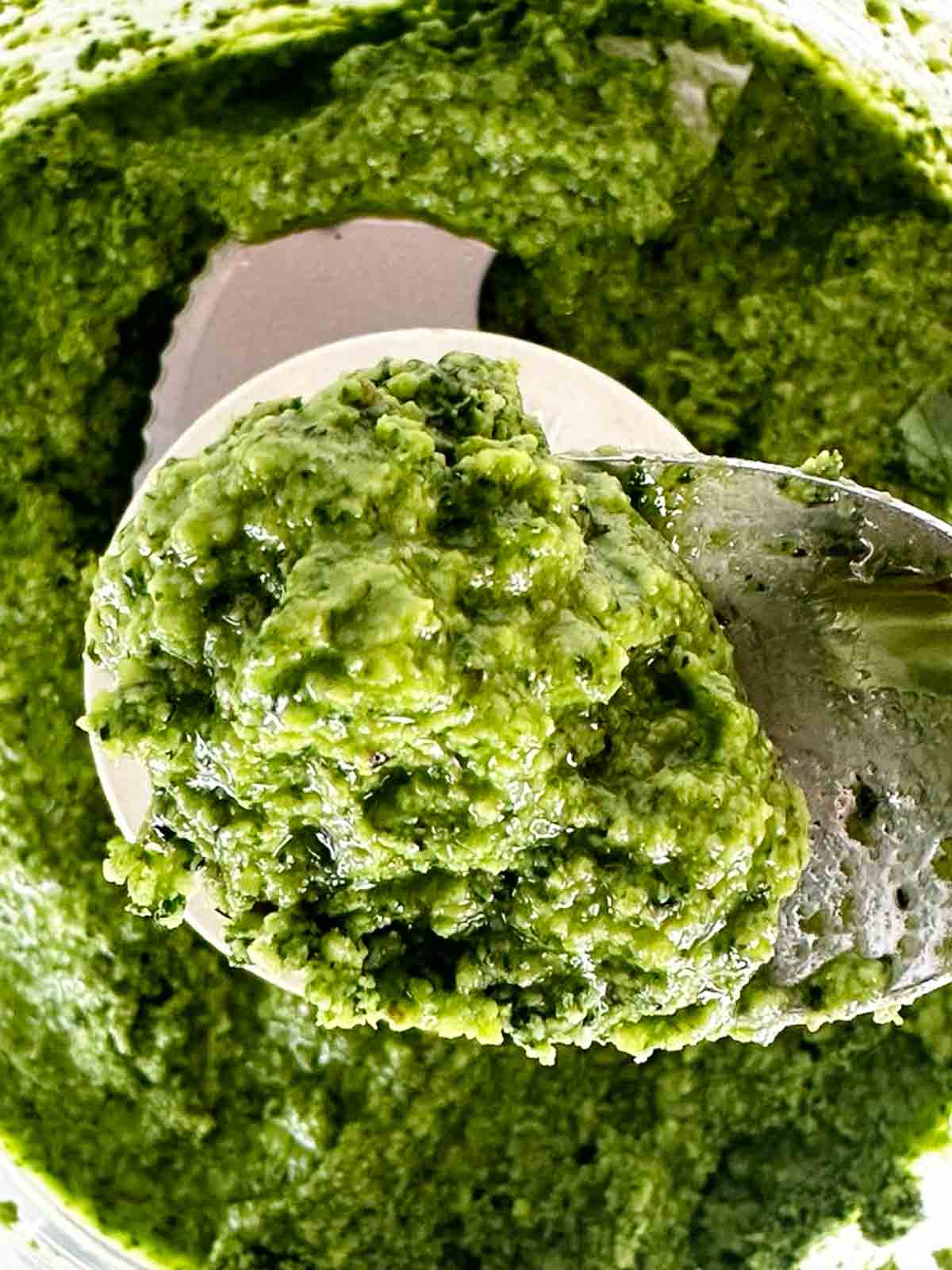
If the pesto is still very thick, put the lid back on your food processor and stream in the remaining olive oil until the pesto reaches a thinner consistency that doesn’t hold its shape on a spoon.
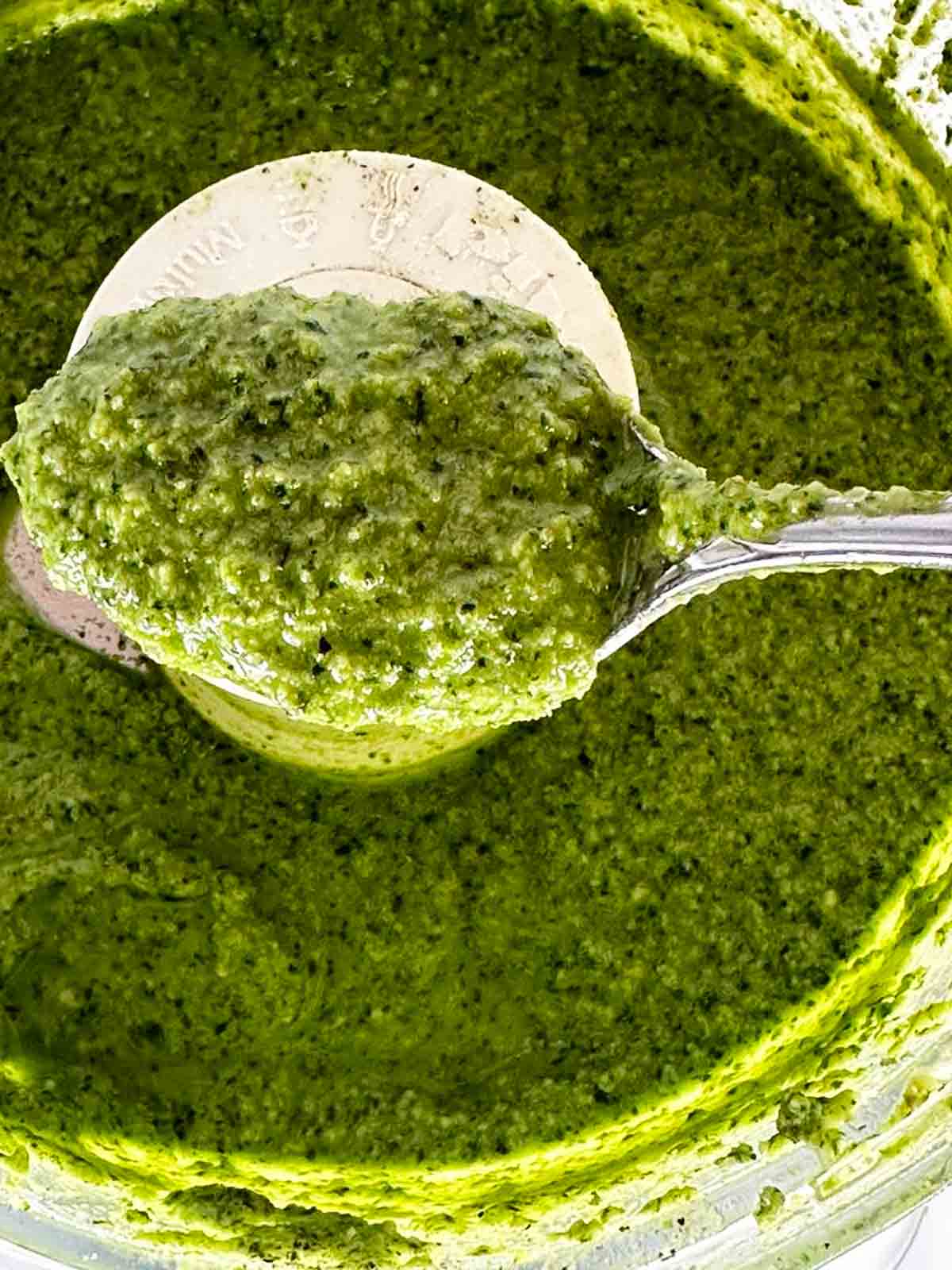
Serve and enjoy!
How to Serve Basil Pesto with Walnuts
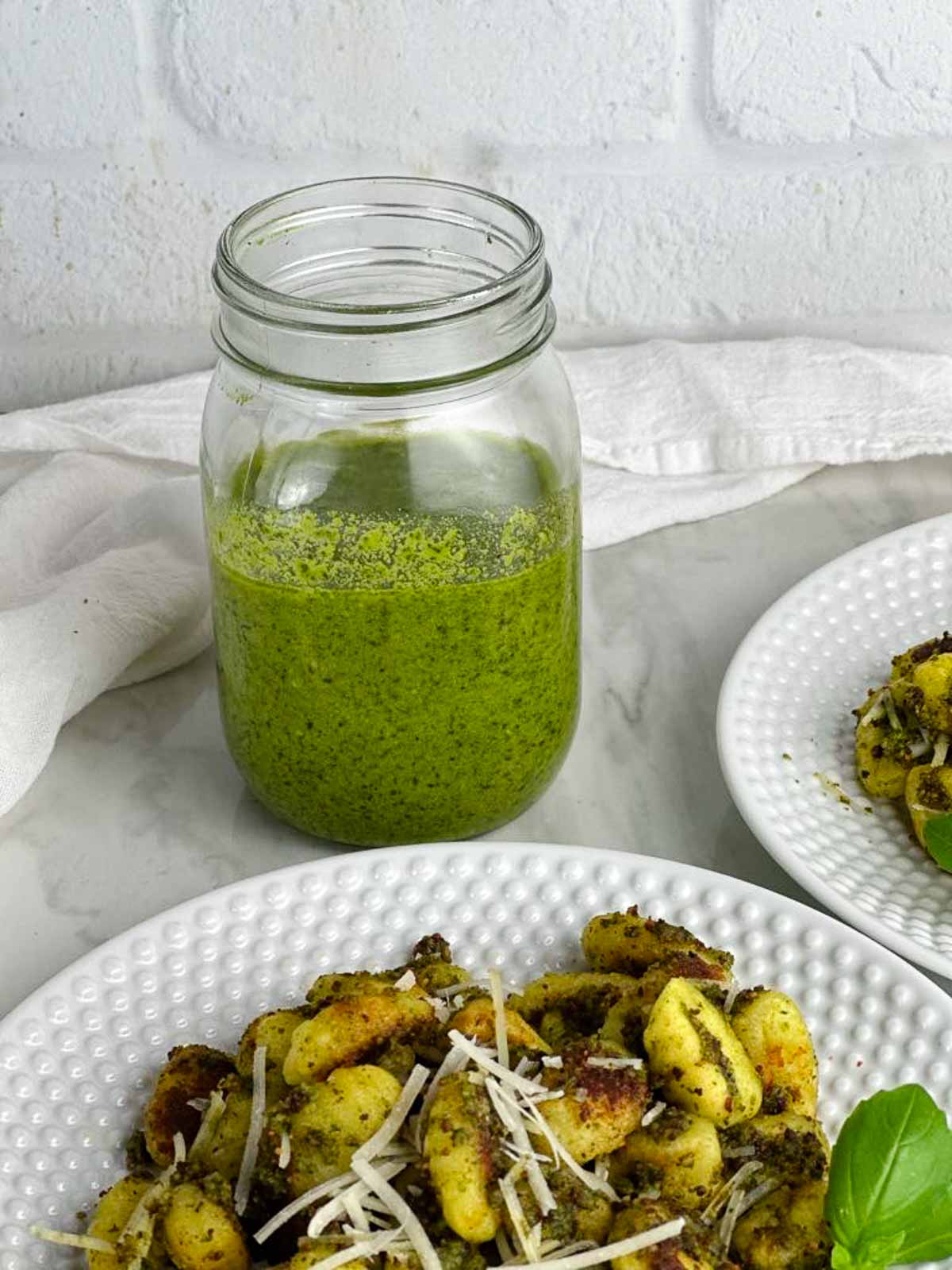
There are so many things you can do with this yummy homemade pesto sauce!
Obviously tossing it with your favorite pasta is If you plan to serve it right away, you can immediately toss it with your favorite pasta or us it in this pasta al pesto recipe or this Chicken Spaghetti Pesto
It’s also so good on salads like:
- a chilled Caprese Tortellini Pasta Salad
- Easy Pesto Caprese Salad
- In place of balsamic reduction on a Burrata Caprese Salad
Oh! And don’t forget sandwiches!
It’s amazing as the pesto on this caprese baguette sandwich and this Easy Caprese Panini Sandwich with Pesto.
And let’s talk about things to drizzle it on or dip into it. Things like:
- Easy Tortellini Caprese Skewers
- Elegant and Easy Prosciutto Caprese Skewers
- Fried Mozzarella Grilled Cheese
- and honestly just a good piece of Italian bread! So dippable!
Storing Pesto Sauce with Walnuts
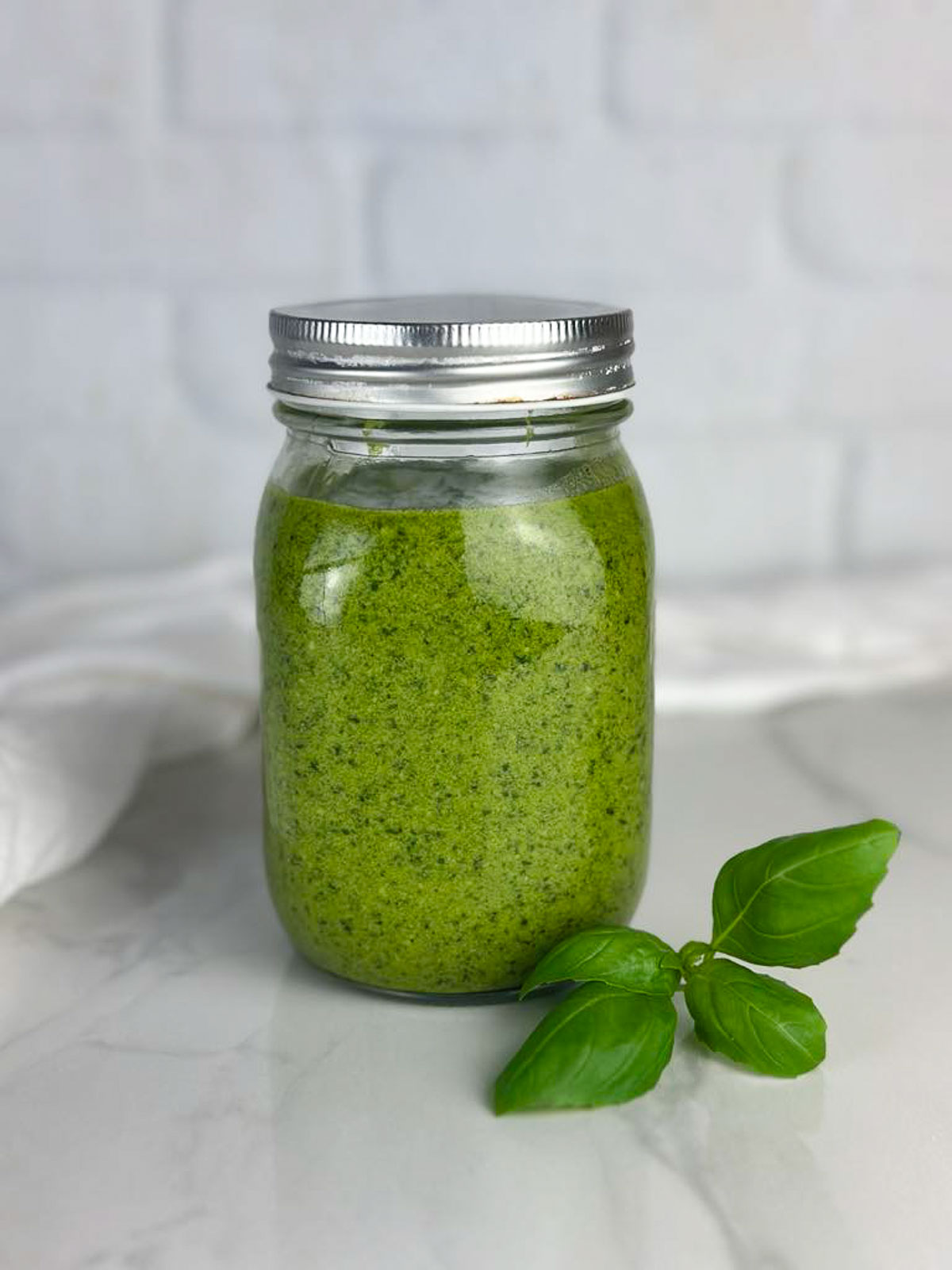
Pesto sauce without pine nuts is a fabulous make ahead sauce because it stores really well.
To store, pour the sauce into an air tight container (I like mason jars for this).
Place the container in your fridge and store for up to a week before using.
Can I freeze this?
Yes!
You can also freeze pesto sauce with walnuts for up to 6 months in a freezer safe container.
To use, allow it to thaw overnight in the fridge.
Do you serve pesto hot or cold?
You do not need to heat up the sauce before using, but if you plan to serve it with a warm pasta, you may want to let it come up to room temperature so the hot pasta can thoroughly warm the sauce as you toss it together.
FAQs
What is pesto sauce made of?
A traditional pesto sauce is made of basil, pine nuts, olive oil, garlic, and a hard cheese, like Parmesan and coarse sea salt. If you have trouble finding pine nuts or are allergic to them, you can substitute in walnuts to make a pesto sauce without pine nuts.
What does walnut pesto taste like?
Basil pesto sauce with walnuts has a fresh, herby flavor thanks to the basil. The cheese adds in a bit of saltiness and richnesss, and the olive oil adds in some additional almost fruity tones. The garlic gives adds in some bite. The walnuts do give this a nuttier flavor than you’d find with pine nuts, but it’s still a pretty mild background flavor that does not take away from the overall deliciousness!
How much pesto should I add to pasta?
In general, you should only add enough pesto to coat your pasta. This is how they tend to make pasta al pesto in Italy. As a rough guide, you should consider adding about two thirds the amount of pesto as dry pasta you are using. So if you make a cup of dry pasta, add about 2/3 of a cup of pesto after you cook it.
Do you add pesto to hot or cold pasta?
When you make pasta to serve with pesto sauce, you should add it to warm, freshly boiled pasta, even if you plan to serve it cold. Make sure you DO NOT RINSE the pasta. You want the extra starch to help the pesto sauce with walnuts stick to the pasta. For cold dishes, adding the pesto to the warm pasta and letting it all cool together helps the pesto stick and also allows the flavors to blend together.
Why is my walnut pesto bitter?
Chances are the walnuts you used weren’t stored properly OR you weren’t using sweet Italian basil. To make sure your pesto isn’t bitter, use freshly purchased walnuts and make sure you are using Italian basil. It should smell fragrant, a little sweet, and a touch spicy but not bitter.
Tips and tricks
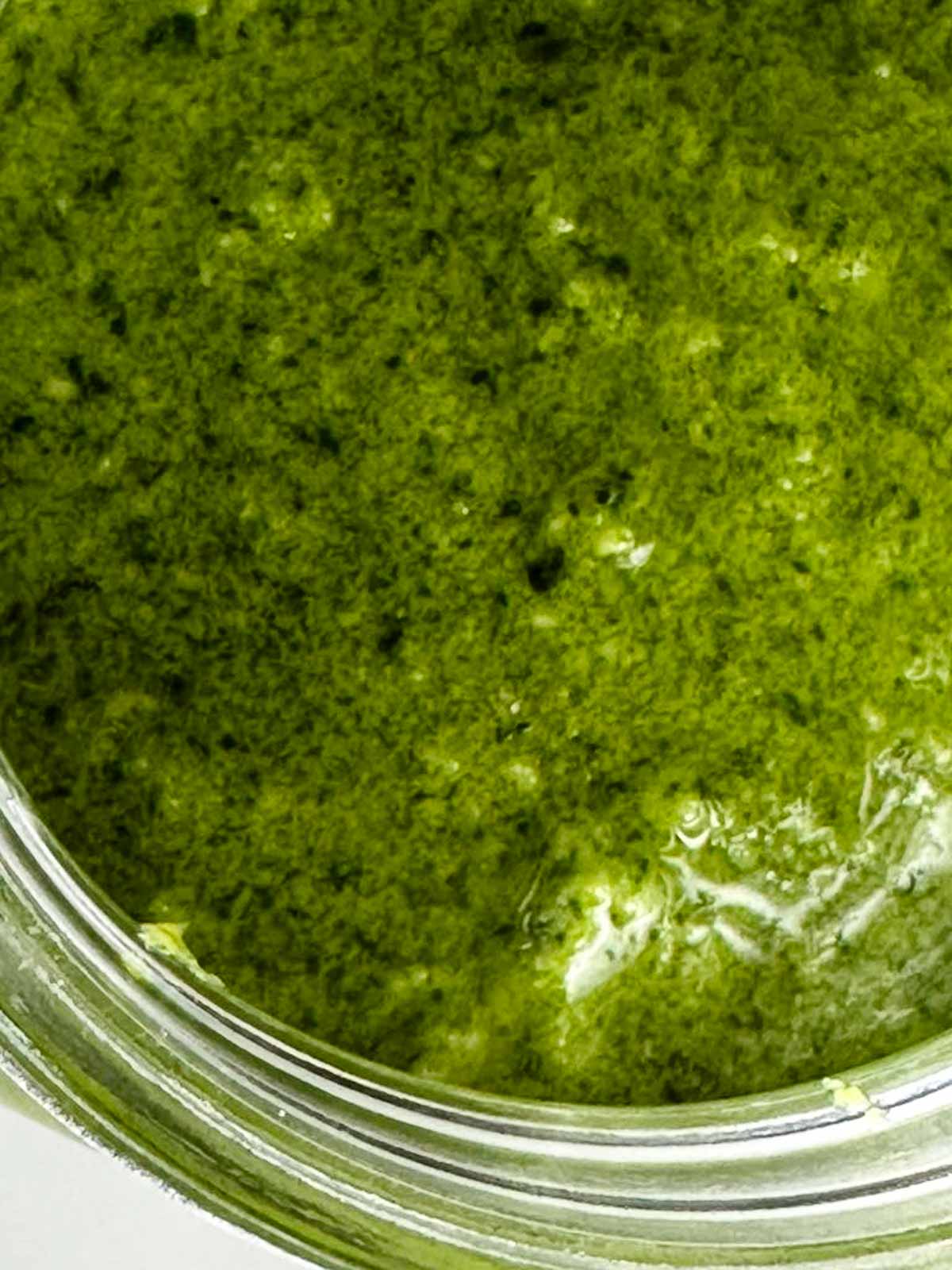
- Use chopped walnuts to speed up the process of mixing the sauce. You may find that rough chopping whole walnuts and the garlic may help with getting consistent sized chunks in the sauce.
- Pesto sauce with walnuts often tastes better if you let it sit for a bit. The more time you allow the basil pesto sauce to sit, the better the flavors come together.
- Before serving cold pesto sauce with hot pasta, let the pesto come back up to room temperature. This will allow the hot pasta to warm the pesto sauce up as you toss it together.
- Garlic adds some heat and spiciness to to the pesto sauce. If you like it less spicy, use a bit less garlic. For more heat, you can add more garlic or even mix in red pepper flakes.
- If you notice your pesto sauce is too thick, you can add a little bit more olive oil. Add it a small amount at a time, remixing, and checking the consistency. Keep doing that until it reaches the consistency you like.
- If your pesto sauce is too thin, you can add a bit more parmesan cheese or walnuts, a small amount at a time, mixing between adding more. Repeat adding more until it reaches the consistency you like.
- For a version of this with a bright citrusy flavor, try this lemon pesto sauce recipe!
Recipes to Use Walnut Pesto
You can also use pesto sauce in other recipes, like:
- Easy Pesto Caprese Salad
- Pesto Chicken Burgers
- Quick Lemon Pesto Chicken and Orzo Skillet
- Easy Baguette Caprese Sandwich with Pesto
- Easy Caprese Panini Sandwich with Pesto
- Caprese Tortellini Pasta Salad with Pesto
- Easy Baked Gnocchi with Pesto Sauce
Did you make this? Let me know!
Did you make this basil pesto sauce with walnuts recipe or any other recipe on my site? Leave me a comment below and let me know how you liked it.
Make sure you follow along with me on Facebook, Pinterest and Instagram to see everything we’ve got going on.
Stay in the know! Sign up for our newsletter that contains the latest recipes and tips.
Equipment
- Food processor
- High power blender (if you don't have a food processor)
Ingredients
- 8 ounces of fresh basil (about 2 cups packed)
- 6 cloves of garlic
- 1 1/4 cup of olive oil extra virgin
- 1/2 cup of Parmesan or Romano cheese
- 1/2 cup walnuts
- 2 pinches salt and pepper (to taste, you can omit)
Instructions
- Add all the ingredients to a food processor and mix for about 1 minute or until it comes together. If it too thick, add about a tablespoon of olive oil and then remix. Repeat until it reaches a consistency you like. If it is too thin, you can add a tablespoon of cheese or walnuts and mix again. Repeat until it reaches a consistency you like.
- Pour or spoon the basil pesto sauce over your favorite pasta, salad, or sandwich.

